Dahr Jamail: How Massacres Become the Norm
How Massacres Become the Norm
By Dahr Jamail
t r u t h o u t | Perspective
From: http://www.truthout.org/docs_2006/040406Z.shtml
Tuesday 04 April 2006
US soldiers killing innocent civilians in Iraq is not news. Just as it was not news that US soldiers slaughtered countless innocent civilians in Vietnam. However, when some rare reportage of this non news from Iraq does seep through the cracks of the corporate media, albeit briefly, the American public seems shocked. Private and public statements of denial and dismissal immediately start to fill the air. We hear, "American soldiers would never do such a thing," or "Who would make such a ridiculous claim?"
It amazes me that so many people in the US today somehow seriously believe that American soldiers would never kill civilians. Despite the fact that they are in a no-win guerrilla war in Iraq which, like any other guerrilla war, always generates more civilian casualties than combatant casualties on either side.
Robert J. Lifton is a prominent American psychiatrist who lobbied for the inclusion of post-traumatic stress disorder (PTSD) in the Diagnostic and Statistical Manual of Mental Disorders after his work with US veterans from Vietnam. His studies on the behavior of those who have committed war crimes led him to believe it does not require an unusual level of mental illness or of personal evil to carry out such crimes. Rather, these crimes are nearly guaranteed to occur in what Lifton refers to as "atrocity-producing situations."
Several of his books, like The Nazi Doctors: Medical Killing and the Psychology of Genocide, examine how abnormal conditions work on normal minds, enabling them to commit the most horrendous crimes imaginable.
Iraq today is most certainly an "atrocity-producing situation," as it has been from the very beginning of the occupation.
The latest reported war crime, a US military raid on the al-Mustafa Shia mosque in Baghdad on March 26th, which killed at least 16 people, is only one instance of the phenomena that Lifton has spoken of.
An AP video of the scene shows male bodies tangled together in a bloody mass on the floor of the Imams' living quarters - all of them with shotgun wounds and other bullet holes. The tape also shows shell casings of the caliber used by the US military scattered about on the floor. An official from the al-Sadr political bloc reported that American forces had surrounded the hospital where the wounded were taken for treatment after the massacre.
The slaughter was followed by an instant and predictable disinformation blitz by the US military. The second ranking US commander in Iraq, Lt. Gen. Peter Chiarelli, told reporters "someone went in and made the scene look different from what it was."
On March 15th, 11 Iraqis, mostly women and children, were massacred by US troops in Balad. Witnesses told reporters that US helicopters landed near a home, which was then stormed by US troops. Everyone visible was rounded up and taken inside the house where they were killed. The victims' ages ranged from six months to 75 years.
The US military acknowledged the raid, but claimed to have captured a resistance fighter and insisted that only four people had been killed. Their claim would have held good but for the discrepancies that the available evidence presents. For one, the photographs that the AP reporter took of the scene reveal a collapsed roof, three destroyed cars and two dead cows. The other indictment comes from the detailed report of the incident prepared by Iraq Police. It matches witness accounts and accuses the American troops of murdering Iraqi civilians.
"The American forces gathered the family members in one room and executed 11 persons, including five children, four women and two men. Then they bombed the house, burned three vehicles and killed the animals." The report includes the observation of local medics that all of the bodies had bullet wounds in the head.
Ahmed Khalaf, the nephew of one of the victims said, "The killed family was not part of the resistance, they were women and children. The Americans have promised us a better life, but we get only death." AP photos of the aftermath showed the bodies of five children, two men and four others covered in blankets being driven to a nearby hospital.
Reminiscent of Vietnam?
Another appalling example of the effect of an "atrocity-producing situation" was experienced last November 19th in Haditha. American troops, in retaliation against a roadside bomb attack, stormed nearby homes and shot dead 15 members of two families, including a three-year-old girl.
US military response? All 15 civilians were killed by the blast of the roadside bomb.
In this case, reality refuted their claim when a student of journalism from Haditha showed up with a video tape of the dead, still in their nightclothes.
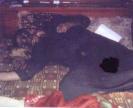
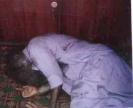
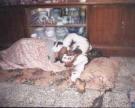
Click for source versions
Killing Iraqis in their homes and while they are in bed is not news either, for during the aftermath of the November 2004 assault on Fallujah, scores of Iraqis were killed by US soldiers in this manner.
Neither is it news that the US military regularly targets ambulances and medical infrastructure. Khaled Ahmed Rsayef, whose brother and six other relatives were killed by the troops, vividly described the blind frustration of the American soldiers and their impulsive revenge at losing one of their own. "American troops immediately cordoned off the area and raided two nearby houses, shooting at everyone inside. It was a massacre in every sense of the word," said Rasayef. While he was not present at the scene, his 15-year-old niece was and her story was corroborated by other residents of the area who witnessed the carnage.
A quick scan of some Arab media reportage for last month exposes further atrocities carried out by US forces in Iraq which find no mention in the corporate media.
March 20, the Daily Dar Al-Salam reported: "US forces destroyed houses in Hasibah and displaced the inhabitants. Also, a source at Abu Ghurayb Secondary School said that US forces raided the school for the third time and arrested the guard."
In December 2003, I personally witnessed US soldiers raid a secondary school in the al-Amiriyah district of Baghdad and detain 16 children.
March 19, Al-Arabia reported: "In another development, seven people, including a woman, were killed in a raid carried out by joint American-Iraqi forces in Al-Dulu'iyah at dawn today. The US Army has so far not confirmed this information."
March 9, Al Sharqiyah Television reported: "US troops opened fire at a civilian vehicle as it passed by Al-Hadba district in the western part of Mosul, northern Iraq. The three occupants of the vehicle were martyred in the incident."
Throughout the three-year history of the US-led catastrophe that is the occupation of Iraq, we have had one instance after another of brutality meted out to innocent Iraqis, by way of direct executions or bombings from the air, or both.
During an attack on a wedding party in May 2004, US troops killed over 40 people, mostly women and children, in a desert village on the Syrian border of Iraq.
APTN footage showed fragments of musical instruments, blood stains, the headless body of a child, other dead children and clumps of women's hair in a destroyed house that was bombed by US warplanes. Other photographs showed dead women and children, and an AP reporter identified at least 10 of the bodies as those of children. Relatives who gathered at a cemetery outside of Ramadi, where all the bodies were buried, told reporters that each of the 28 fresh graves contained between one and three bodies.
The few survivors of the massacre later recounted how in the middle of the night long after the wedding feast had ended, US jets began raining bombs on their tents and houses.
Mrs. Shihab, a 30-year-old woman who survived the massacre, told the Guardian, "We went out of the house and the American soldiers started to shoot us. They were shooting low on the ground and targeting us one by one." She added that she ran with her two little boys before they were all shot, including herself in the leg. "I left them because they were dead," she said of her two little boys, one of whom was decapitated by a shell. "I fell into the mud and an American soldier came and kicked me. I pretended to be dead so he wouldn't kill me."
Thereafter, armored military vehicles entered the village, shooting at all the other houses and the people who were starting to assemble in the open. Following these, two Chinook helicopters offloaded several dozen troops, some of who set explosives in one of the homes and a building next to it. Both exploded into rubble as the helicopters lifted off.
Mr. Nawaf, one of the survivors, said, "I saw something that nobody ever saw in this world. There were children's bodies cut into pieces, women cut into pieces, men cut into pieces. The Americans call these people foreign fighters. It is a lie. I just want one piece of evidence of what they are saying."
Hamdi Noor al-Alusi, the manager of al-Qa'im general hospital, the nearest medical facility to the scene of the slaughter, said that of the 42 killed, 14 were children and 11 women. "I want to know why the Americans targeted this small village," he said, "These people are my patients. I know each one of them. What has caused this disaster?"
As usual, the US military ran a disinformation campaign saying the target was a "suspected safe-house" for foreign fighters and denied that any children were killed. The ever pliant US Brig. Gen. Mark Kimmitt told reporters that the troops who reported back from the operation "told us they did not shoot women and children."
Topping his ridiculous claim was the statement of Maj. Gen. James Mattis, commander of the 1st Marine Division. "How many people go to the middle of the desert ... to hold a wedding 80 miles (130km) from the nearest civilization?"
Perhaps someone should have informed him that these farmers and nomads often "go to the middle of the desert" because they happen to live there.
"These were more than two dozen military-age males. Let's not be naïve," Mattis stated before being asked by a reporter to comment on the footage on Arabic television which showed a child's body being lowered into a grave. His brilliant response was: "I have not seen the pictures but bad things happen in wars. I don't have to apologize for the conduct of my men."
If the US were a member of the International Criminal Court, Maj. Gen. Mattis may well have been in The Hague right now being tried for aiding and abetting war crimes. How can someone holding an official position like Mattis publicly sanction atrocities?
It is about unnatural responses such as these that Dr. Lifton has written extensively. In a piece he wrote for the New England Journal of Medicine in July 2004, Lifton addressed the issue of US doctors being complicit in torturing Iraqis in Abu Ghraib. This article sheds much light on the situation in Iraq. If we substitute "doctors" with "soldiers" it is easy to understand why American soldiers are regularly committing the excesses that we hear of.
Lifton writes, "American doctors at Abu Ghraib and elsewhere have undoubtedly been aware of their medical responsibility to document injuries and raise questions about their possible source in abuse. But those doctors and other medical personnel were part of a command structure that permitted, encouraged, and sometimes orchestrated torture to a degree that it became the norm - with which they were expected to comply - in the immediate prison environment."
He continues, "The doctors thus brought a medical component to what I call an "atrocity-producing situation" - one so structured, psychologically and militarily, that ordinary people can readily engage in atrocities. Even without directly participating in the abuse, doctors may have become socialized to an environment of torture and by virtue of their medical authority helped sustain it. In studying various forms of medical abuse, I have found that the participation of doctors can confer an aura of legitimacy and can even create an illusion of therapy and healing."
I have personally experienced this. Standing with US soldiers at checkpoints and perimeters of operations in Iraq, I have seen them curse and kick Iraqis, heard them threatening to kill even women and children and then look at me as if they had merely said hello to them. My status of journalist did not deter them because they saw no need for checks.
Having stood with soldiers anticipating that each moving car would turn into a bomb and each passerby into a suicide bomber, I have tasted the stress and fear these soldiers live with on a daily basis. When one of their fellow soldiers is killed by a roadside bomb, the need for revenge may be directed at anything. And repeated often enough, the process gets socialized.
It's about this attitude brought on by the normalization of the abnormal under "atrocity-producing situations" that Dr. Lifton speaks. Unless of course we consider Mattis and others like him to be rare sociopaths who are able to participate in atrocities without suffering lasting emotional harm.
And it is this attitude that is responsible for the incessant replication of wanton slaughter and madness in Iraq today.
Back in November of 2004, I wrote about 12-year-old Fatima Harouz. She lay dazed in a crowded room in Yarmouk Hospital in Bahgdad, feebly waving her bruised arm at flies. Her shins had been shattered by bullets from US soldiers when they fired through the front door of her home in Latifiya, a small city just south of Baghdad. Small plastic drainage bags filled with red fluid sat upon her abdomen, where she took shrapnel from another bullet.
Her mother, who was standing with us, said, "They attacked our home and there weren't even any resistance fighters in our area." Her brother had been shot and killed, and his wife was wounded as their home was ransacked by soldiers. "Before they left, they killed all of our chickens," she added, her eyes a mixture of fear, shock and rage.
On hearing the story, a doctor looked at me sternly and asked, "This is the freedom ... in their Disney Land are there kids just like this?"
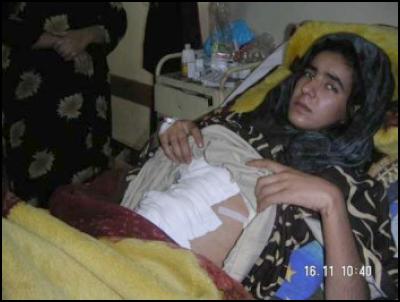
Click for source version
Another wounded young woman in a nearby hospital bed, Rana Obeidy, had been walking home with her brother. She assumed the soldiers shot her and her brother because he was carrying a bottle of soda. This happened in Baghdad. She had a chest wound where a bullet had grazed her, unlike her little brother, whom the bullets had killed.
There exist many more such cases. Amnesty International has documented scores of human rights violations committed by US troops in Iraq during the first six months of the occupation. To mention but a few:
US troops shot dead and injured scores of Iraqi demonstrators in several incidents. For example, seven people were reportedly shot dead and dozens injured in Mosul on 15 April.
At least 15 people, including children, were shot dead and more than 70 injured in Fallujah on 29 April.
Two demonstrators were shot dead outside the Republican Palace in Baghdad on 18 June.
On 14 May, two US armed vehicles broke through the perimeter wall of the home of Sa'adi Suleiman Ibrahim al-'Ubaydi in Ramadi. Soldiers beat him with rifle butts and then shot him dead as he tried to flee.
US forces shot 12-year-old Mohammad al-Kubaisi as they carried out search operations around his house in the Hay al-Jihad area in Baghdad on 26 June. He was carrying the family bedding to the roof of his house when he was shot. Neighbors tried to rush him to the nearby hospital by car, but US soldiers stopped them and ordered them to go back. By the time they returned to his home, Mohammad al-Kubaisi was dead.
On 17 September, a 14-year-old boy was killed and six people were injured when US troops opened fire at a wedding party in Fallujah.
On 23 September, three farmers, 'Ali Khalaf, Sa'adi Faqri and Salem Khalil, were killed and three others injured when US troops opened a barrage of gunfire reportedly lasting for at least an hour in the village of al-Jisr near Fallujah. A US military official stated that this happened when the troops came under attack but this was vehemently denied by relatives of the dead. Later that day, US military officials reportedly went to the farmhouse, took photographs and apologized to the family.
This last incident ended in a way similar to the one I covered in Ramadi in November, 2003. On the 23rd of that month during Ramadan, US soldiers raided a home where a family was just sitting down together to break their fast.
Three men of the family had their hands tied behind them with plastic ties and were laid on the ground face down while the women and children were made to stand inside a nearby storage closet.
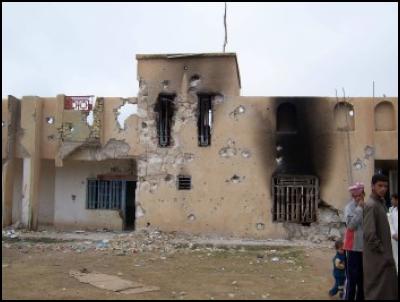
Click for source version
Khalil Ahmed, 30 years old, the brother of two of the victims and cousin with a third, wept when he described to me how after executing the three men the soldiers completely destroyed the home, using Humvees with machine guns, small tanks, and gunfire from the many troops on foot and helicopters.
"We don't know the reason why the soldiers came here. They didn't tell us the reason. We don't know why they killed our family members." Khalil seemed to demand an answer from me. "There are no weapons in this house, there are no resistance fighters. So why did these people have to die? Why?"
Khalil told me that the day after the executions took place, soldiers returned to apologize. They handed him a cake saying they were sorry that they had been given wrong information by someone that told them there were resistance fighters in their house.
This is only a very small sampling. The only way to prevent any of this from being repeated ad infinitum is to remove US soldiers from their "atrocity-producing situation" in Iraq. For it is clearer than ever that the longer the failed, illegal occupation persists, the larger will be the numbers of Iraqis slaughtered by the occupation forces.
Dahr Jamail is an independent journalist who spent over 8 months reporting from occupied Iraq. He presented evidence of US war crimes in Iraq at the International Commission of Inquiry on Crimes Against Humanity Committed by the Bush Administration in New York City in January 2006. He writes regularly for TruthOut, Inter Press Service, Asia Times and TomDispatch, and maintains his own web site, dahrjamailiraq.com.


 Binoy Kampmark: Secrecy And Virtue Signalling - Another View Of Signalgate
Binoy Kampmark: Secrecy And Virtue Signalling - Another View Of Signalgate Gordon Campbell: On The Americanising Of NZ’s Public Health System
Gordon Campbell: On The Americanising Of NZ’s Public Health System Ian Powell: Trumpian Health Leadership
Ian Powell: Trumpian Health Leadership Eugene Doyle: Disruption - Historians Challenge Russophobic Propaganda
Eugene Doyle: Disruption - Historians Challenge Russophobic Propaganda Ramzy Baroud: War, Doublethink, And The Struggle For Survival - Geopolitics Of The Gaza Genocide
Ramzy Baroud: War, Doublethink, And The Struggle For Survival - Geopolitics Of The Gaza Genocide Binoy Kampmark: Authoritarian Politics - Netanyahu’s War On Israeli Institutions
Binoy Kampmark: Authoritarian Politics - Netanyahu’s War On Israeli Institutions